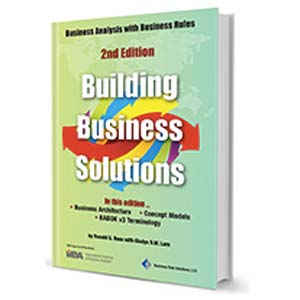Whirlwind Tour of the Business Agility Manifesto
The Business Agility Manifesto[1] was officially released at the 2017 Building Business Capability (BBC) conference in Orlando, FL. Let me give you a whirlwind tour of key points it makes.
Article 1 establishes that an appropriate infrastructure for retention of business knowledge and corporate memory is essential for managing perpetual change. If an agile approach isn't addressing that root-cause problem, things won't improve over time no matter how clever or initially invigorating the approach.
Article 2 focuses on inclusion and delivery of business knowledge into business solutions. Business knowledge can be most readily understood in terms of business vocabulary and business rules. Those are things everybody should be applying in their projects.
Article 3 indicates that projects must be justified directly on the basis of value creation for end-customers and business strategy, not software features. The point should be self-evident.
Article 4 introduces value chain models, which provide a basis to explore, analyze, and explain opportunities for integration. They also provide a framework to challenge priorities and to rationalize project scope. They can bring sanity to what often seems like a chaotic and irrational world.
Article 5 essentially says you should be doing business vocabulary and business rules in your projects — and those are not the same thing as software development.
Article 6 is a blockbuster. It says that business knowledge should be expressed in an explicit form accessible to all business audiences — not just software code for software developers.
Article 7 talks about how to treat business knowledge so that it is retainable and reusable.
Article 8 introduces the idea of a single source of truth for business knowledge. It's not talking about data or meta-data. Single-sourcing, by the way, should start at the project level.
Article 9 emphasizes the importance of correct results, not just getting results fast. This point should also be obvious, but unfortunately projects often lose sight of it.
Article 10 highlights the persistence of business knowledge, even as channels, technologies, organizational schemes, and individual workers come and go. Business knowledge is actually the most fundamental asset a company owns.
I've simplified some, but that's the basic message of the Manifesto's ten articles. The Manifesto message, however, doesn't stop there. Important supplemental materials are included on the Manifesto website.
One of the Supplements was specifically written for IT Project Professionals.[2] I'd highly recommend having a look at that set of insights to sharpen your understanding of today's debates over agile and why a knowledge-orientation is essential. Off the record, that's where the really controversial stuff is. (And yes, that is meant as a teaser.)References
[1] The Business Agility Manifesto: Building for Change, by Roger T. Burlton, Ronald G. Ross, and John A. Zachman, 2017, https://busagilitymanifesto.org/![]()
[2] https://busagilitymanifesto.org/accompaniments/supplements/sidebar-for-it-project-professionals ![]()
# # #
About our Contributor:
Online Interactive Training Series
In response to a great many requests, Business Rule Solutions now offers at-a-distance learning options. No travel, no backlogs, no hassles. Same great instructors, but with schedules, content and pricing designed to meet the special needs of busy professionals.










How to Define Business Terms in Plain English: A Primer
How to Use DecisionSpeak™ and Question Charts (Q-Charts™)
Decision Tables - A Primer: How to Use TableSpeak™
Tabulation of Lists in RuleSpeak®: A Primer - Using "The Following" Clause
Business Agility Manifesto
Business Rules Manifesto
Business Motivation Model
Decision Vocabulary
[Download]
[Download]
Semantics of Business Vocabulary and Business Rules